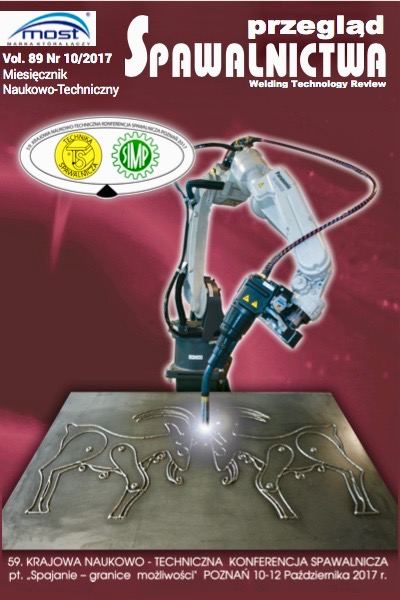Robotic welding of high-strength DOCOL 1200M steel with Laser SEAM Stepper system
Main Article Content
Abstract
This paper will present the influence of joining process parameters on the structure and properties of overlapped welded joints of 1.8 mm DOCOL 1200M steel using Laser SEAM Stepper method. The Laser SEAM Stepper (LSS) system by IPG Laser GmbH combines the advantages of laser-beam welding with the use of attached pressing unit. The DOCOL 1200M martensitic steel is mainly intended for manufacturing car bumpers, side bars and other user-safety elements of motor vehicles. The obtained welded joints were subjected to micro- and macroscopic metallographic examination and hardness measurement. The visual inspections and non-destructive testing made it possible to develop the field of welding parameters to allow obtaining full penetration joints (depending on requirements) or partial penetration joints. For present welding parameters, i.e. rate of feed and length of weld, which are constant, the actual length of weld is determined by welding frequency. With the increase in welding power, the penetration depth increases. In each case, the microscopic examinations revealed martensitic structure in the weld area, and with the increase in linear welding energy the size of martensite needles became larger, especially in relation to the native material. In HAZ, the martensitic structure is tempered. It has been shown that with appropriately selected parameters the Laser SEAM Stepper method is suitable for welding the DOCOL 1200M steel.
in polish
Zrobotyzowane spawanie Laser SEAM Stepper stali wysokowytrzymałej DOCOL 1200M
W pracy zostanie przedstawiony wpływ parametrów procesu łączenia na strukturę i własności połączeń spawanych na zakładkę stali DOCOL 1200M o grubości 1,8 mm techniką Laser SEAM Stepper. Stal DOCOL 1200M o strukturze martenzytycznej, przeznaczona jest głównie na wytwarzanie zderzaków samochodowych, belek bocznych oraz innych elementów zapewniających bezpieczeństwo użytkownika pojazdów mechanicznych. Uzyskane złącza spawane zostały poddane badaniom metalogra cznym mikro- i makroskopowym oraz pomiarowi twardości. Przeprowadzone badania wizualne oraz badania nieniszczące pozwoliły na opracowanie pola parametrów spawania pozwalające uzyskać połączenia z pełnym przetopem (w zależności od wymagań) lub połączenia bez pełnego przetopienia. Dla zadanych parametrów spawania, tj. prędkości posuwu oraz długości spoiny, które są stałe, rzeczywista długość spoiny jest uwarunkowana częstotliwością przesuwu wiązki laserowej. Wraz ze wzrostem mocy spawania zwiększa się głębokość przetopu. Badania mikroskopowe w obszarze spoiny ujawniły w każdym przypadku strukturę martenzytyczną, przy czym wraz ze wzrostem energii liniowej spawania wielkość igieł martenzytu rośnie, zwłaszcza w stosunku do materiału rodzimego. W SWC dochodzi do odpuszczenia struktury martenzytycznej. Wykazano, że dla odpowiednio dobranych parametrów metoda Laser SEAM Stepper nadaje się do zgrzewania stali DOCOL 1200M.
Downloads
Article Details
Creative Commons CC BY 4.0 https://creativecommons.org/licenses/by/4.0/
Welding Technology Review (WTR) articles are published open access under a CC BY licence (Creative Commons Attribution 4.0 International licence). The CC BY licence is the most open licence available and considered the industry 'gold standard' for open access; it is also preferred by many funders. This licence allows readers to copy and redistribute the material in any medium or format, and to alter, transform, or build upon the material, including for commercial use, providing the original author is credited.
References
Grajcar A., Różański M.: Spawalność wysokowytrzymałych stali wielofazowych AHSS, Przegląd Spawalnictwa nr 3/2014, str. 22-27.
Nishioka K., Ichikawa K.: Progress in termomechanical control of steel plates and their commercialization, Science and Technology of Advanced Materials, vol. 13, No. 2, April 2012, pp. 1-20.
Krajewski S., Nowacki J.: Mikrostruktura i właściwości stali o wysokiej wytrzymałości AHSS, Przegląd Spawalnictwa nr 7/2011, str. 45-50.
Stano S.: Spawanie laserowe blach o zróżnicowanej grubości przeznaczonych na półfabrykaty karoserii samochodowych typu tailored blanks, Biuletyn Instytutu Spawalnictwa nr 2/2005, str. 24-28.
Chen B., Yu H.: Hot ductility behaviour of V-N and V-Nb microalloyed steels, International Journal of Minerals, Metallurgy and Materials, vol. 19, No. 6, June 2012, p. 525.
Lee, H. Shin, K. Park: Evaluation of high strength TMCP steel weld for use in cold regions, Journal of Constructional Steel Research 74 (2012) pp. 134-139.
Górka J.: Weldability of thermomechanically treated steels having a high yield point, Archives of Metallurgy and Materials, Volume 60, Issue 1/2015, pp. 469-475.
Lisiecki A.: Diode laser welding of high yield steel. Proc. of SPIE Vol. 8703, Laser Technology 2012: Applications of Lasers, 87030S (January 22, 2013), DOI: 10.1117/12.2013429.
Adamczyk J., Opiela M.: In uence of the thermo-mechanical treatment parameters on the inhomogeneity of the austenite structure and mechanical properties of the Cr-Mo steel with Nb, Ti and B microadditions, Journal of Materials Processing Technology, vol. 157-158, 2004, pp. 456-461.
Górka J.: Study of structural changes in S700MC steel thermomechanically treated under the in uence of simulated welding thermal cycles, Indian Journal of Engineering and Materials Sciences, Vol. 22, October 2015, pp. 497-502.
Grajcar A., Różański M., Stano S.: Effect of heat input on microstructure and hardness distribution of laser welded Si-Al TRIP-type steel, Advances Material Science Engineering. 2014, Article ID 658947, pp. 1-8.
Godwin K., Yong O., Microstructure and fatigue performance of buttwelded joints in advanced high-strength steels, Materials Science & Engineering A 597 (2014), pp. 342-348.
Siewert A. Krastel K., Fiber Laser Seam Stepper Replacing Resistance Spot-Welding. A cost-effective laser based tool to conventional welding technology, Laser Technik Journal, 4/2014.
Materiały rmy IPG Photonics, http://www.ipgphotonics.com
